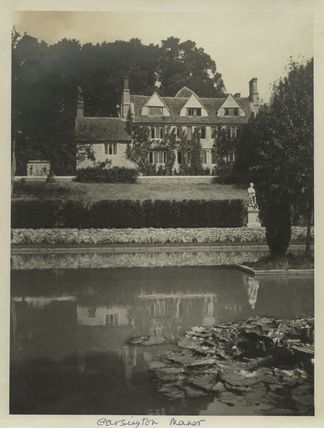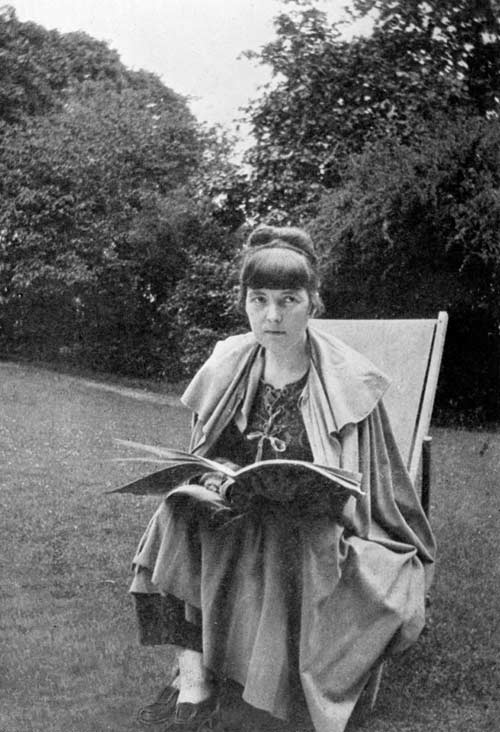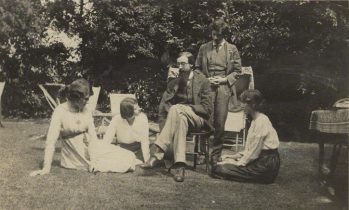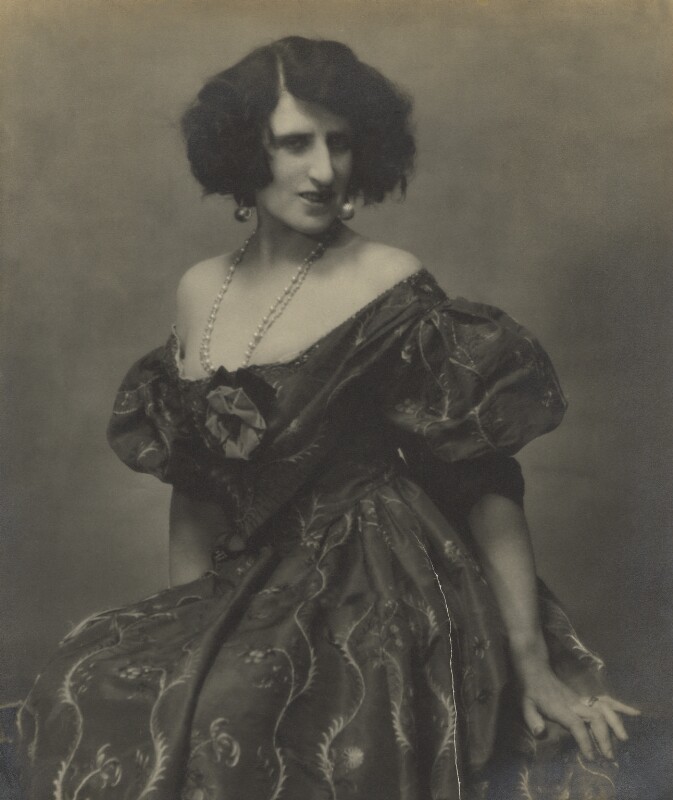
"I have lived long enough. My way of life
Is fall'n into the sere, the yellow leaf,
And that which should accompany old age,
As honor, love, obedience, troops of friends,
I must not look to have, but, in their stead,
Curses, not loud but deep, mouth-honor, breath
Which the poor heart would fain deny and dare not."
-Shakespeare, Macbeth, Act 5, Scene 3.
"Before the 'great war' of 1914-18 was over it altered the face of our civilisation. It left the European nations impoverished, shell-shocked, discouraged and unsettled … In seeking to understand the reasons for this great decay, we have of course to marshal in our minds all that nexus of disastrous events of which the Great War was the first, and of which Great War No. 2, now in preparation, will be the next."
- Wyndham Lewis, Blasting and Bombardiering (1937).
Aldous
Huxley's first novel, published in 1921, is a desiderium of
a peculiarly English class of aristocrats and intellectuals
who lived in an era that withered away a century ago. It
limns a frothy pastel portrait solidly in the tradition of
the English country house novels of Thomas Love Peacock, in
which a diverse group of characters descend upon an country
estate to leech off their host. There is little plot
development, as they spend most of their time eating,
drinking, and holding forth on their personal intellectual
conceits, but a plethora of effervescent classical allusions
undercuts any sense of pastoral innocence. Like his
contemporaries Evelyn Waugh, Anthony Powell, Ronald Firbank,
and P. G. Wodehouse, Huxley drew on his immediate social
circle to sketch out faded, yet fascinating profiles of the
various 'free thinkers' who regularly assembled at
Garsington Manor, home of the notorious society hostess,
Lady Ottoline Violet Anne Morrell.
Situated high on a hill near Oxford, with a sweeping view south-west across the Thames valley to the Chilterns, the three-storey manor house was originally built by William Wickham in the 1630s on the site of a medieval property formerly owned by Geoffrey Chaucer’s son and monastic buildings once under the auspices of Abingdon Abbey. Ottoline and her husband Philip, a Liberal MP from a wealthy family of solicitors, purchased the estate for £8,450 in 1913. Working with the architect Philip Tilden, they completely restored the house in the 1920s, adding a formal Italianate garden inspired by the Villa Capponi, near Florence. The parterre contains twenty-four square flower beds with Irish yew trees at each corner, a large ornamental pool enclosed by yew hedges and set about with statues, beyond which lies a wild garden with lime-tree avenues, various shrubs, a stream and fish pond. With its mullioned and arched windows, the historic house was considered to be much more ancient, probably because many Oxford builders continued to use 16th century windows in gentry-houses of the early 17th century.
The Morrells enjoyed an open relationship and both took a series of lovers, despite which their marriage remained remarkably firm. Dismayed by the patriotic hysteria and rampant xenophobia of the time, Philip protested against the outbreak of war in the House of Commons and the Morrells decided to made their home a refuge for conscientious objectors. It soon became a well-known retreat for many writers and artists both during and after WWI, some of whom were known collectively as the Bloomsbury Group, including Virginia and Leo Woolf, Roger Fry, Clive Bell, Duncan Grant, Dora Carrington, E.M Forster, John Middleton Murry, and Katherine Mansfield. Ottoline's patronage and promotion was also of great assistance to a host of other prominent painters, authours, and scholars, such as Siegfried Sassoon, Bertrand Russell, D. H. Lawrence, Wyndham Lewis, Lytton Strachey, the Sitwell siblings, T. S. Eliot, Graham Greene, Dylan Thomas, and the portrait painter Mark Gertler.
When Sassoon's poem To Victory was published in The Times in January 1916, Ottoline was so impressed she wrote him a gushing letter of admiration. In August, Robbie Ross, a mutual friend and Oscar Wilde's executor, introduced him to Ottoline, who welcomed his arrival as that of “an angel,” longed for ever since their first correspondence. Sassoon, whose Garsington nickname was ‘Cyprian Oyde’ (cyprianoid, or carp-like) because he was always complaining about something, wanted to make a public stand against the war and soon found himself among like-minded pacifists such as Russell, who encouraged him to write his Soldier's Declaration. Sassoon and Ivor Novello, who enjoyed a brief relationship in the 1920s, first met each other at Garsington, where all manner of salacious scuttlebut and ribald gossip soon began to proliferate. There were rumours that Ottoline had dispatched her live-in lover, Russell, to a house called Conscience Cottage; that a diseased peacock (actually, a less than fresh turkey) was served to her guests at a dinner party; and that Ottoline had once dared Grant to dive beneath the murky waters of the fish pond to find out whether she was naked, when in fact she was dressed in a perfectly respectable bathing costume..Not only did Ottoline conduct an ongoing affair with Russell for years, but Philip begrudgingly accepted the situation (as did Russell’s wife), and apparently fathered two children out of wedlock over the course of one particularly fecund summer. Eliot's neurasthenic wife Vivien also had a brief fling with Russell, whose extreme halitosis never seemed to repulse his many female admirers. The malicious tittle-tattle multiplied exponentially, enveloping the old manor house and its hospitable owners within a web of scandal and mockery. Those who gathered there were hardly strangers to drama and intrigue and would hardly have been surprised when Garsington was variously described as a “cesspool of slime,” “the setting for a Mozart opera,” “Shandygaff Hall,” and “a Boccaccio palace.”
The Christmas celebrations of 1914 got particularly out of hand when Mansfield and her husband Murry, the Russian-born émigré writer and translator S.S. 'Kot' Koteliansky, Gertler, Frieda and D.H Lawrence were all staying at Gilbert Cannan’s windmill cottage in nearby Buckinghamshire, and someone suggested staging an improvised play. The gathering became so inebriate that the assembled guests were unable to carve the Christmas pig and the play descended towards a bacchanalia. Mansfield flirted so outrageously with Gertler that Lawrence used it for the episode in which Gudrun elopes with the artist Loerke in Women in Love. It may also have given rise to Virginia Woolf's 1941 novel Between the Acts, while Gertler's relationship with the bisexual Dora Carrington was the inspiration behind Cannan's novel Mendel. Koteliansky was close friends with Gertler, Lawrence, and the Woolfs, all of whom he corresponded with extensively. He also adored Mansfield and, although his romantic affection for her was not reciprocated, the two maintained a close relationship until her untimely death in 1923. Complicating the situation was the fact that he was also business manager of The Adelphi, a prominent literary journal founded by Murry that published pieces by Mansfield, Thomas, Lawrence, and many other luminaries of early twentieth-century English letters.
The back-biting was
constant and intense, with Mansfield proving to be an
especially polarising figure. Although Ottoline was close to
both her and her husband, a row ensued in 1917 when Murry
told his wife that Ottoline was in love with him, and again
in 1918 when he published a hostile review of Sassoon,
leading Ottoline to write that “A mighty quarrel is raging
between John Middleton Murry and myself.” it is not clear
why Eliot felt such sustained hostility to Mansfield, who
took a vitriolic dislike to Vivien, as she explained in a
1920 letter to Violet Schiff - “The Elliots [sic] have
dined with us tonight. The are just gone and the whole room
is quivering. John has gone downstairs to see them
off. Mrs. E's voice rises “O don't commiserate Tom; he's
Although Eliot was never
less than courteous towards Ottoline, some of her guests
took great delight in mocking their hostess. Lawrence
depicted her in Women in Love as the character
Hermione, who treated her guests “like prisoners
marshalled for exercise,” while Sassoon ridiculed her
imposing height, beaked nose, and titian hair, describing
her as an English eccentric wobbling her way down a ladder
to greet him in a pair of billowing pink silk bloomers.
Gertler wasn't afraid to let Ottoline know the brutal truth
about the chattering writers and artists who filled her home
and her friendships with Lawrence and Sassoon were ruined as
a result. "I am known as a dangerous and designing woman,
immoral and unclean," she wrote in January 1918. "Nobody
likes me ... " What were Garsington's younger inhabitants
(some of whom lingered for months, and even years, at the
Morrell's expense) to make of an extravagant older woman who
talked in drawling “bassoon“ tones about the Soul, while
indulging in romantic affairs not only with Russell, but
also Augustus John, Henry Lamb, and even a hunky young
stonemason who worked in her garden? How could Lawrence
forgive a society hostess who thought his German wife should
be put in a sack and drowned? And how could Sassoon resist
sniggering when Ottoline presented him with a handwritten
manifesto, solemnly urging him to "live the noble life: to
live freely, recklessly, with clear reason released from
convention"? Much was
expected from a hostess whose wealth was inaccurately
assumed to be astronomical. It was Lawrence who re-imagined
Garsington as "the Boccaccio palace where they told all the
Decamerone," with Ottoline as its gracious benefactor. He
requested a converted cottage with a handsome workroom and
adjoining bathroom, to be furnished and heated to the
standard that his boisterous baroness wife required.
Informed that the Morrells could not afford to gratify this
request, Lawrence was forced to settle for being a mere
guest of the manor. Despite the cruelty of his portrait of
Ottoline as Lady Hermione, he was charmed by Garsington's
natural beauty. "My God it breaks my soul," he wrote to
Cynthia Asquith, "This England, these shafted windows, the
elm trees, the blue distance ... " Clive Bell, one of
Bloomsbury's most promiscuous spouses, settled
discontentedly into the cottage that Lawrence had rejected.
Bitterly resenting his demotion to the status of a farm
worker, he was less appreciative. Ottoline's interior decor
reminded him of a parrot house, while he considered her love
affairs outrageously pathetic. Lytton Strachey, one of the
chief purveyors of gossip about Garsington, had a more
complex attitude. "I imagine wonders," he told Ottoline in
June 1915, "ponds, statues, yew hedges, gold paint … you
needn't be afraid of my critical eye." While he trilled to
her from his comfortable first-floor bedroom, reserved
solely for his personal use, that "only the tongues of
angels" could convey his gratitude and joy, he grumbled to
others about the detestable guests, abysmal food, ridiculous
parlour games, and imbecilic hosts - "They're so stupid, so
painfully stupid ... " Why then, inquired a puzzled Virginia
Woolf, did he visit Garsington so frequently and stay for so
long? As with so many of Ottoline's guests from Bloomsbury,
the real answer was that Strachey found himself embarrassed
by his indebtedness to a woman for whom he felt a genuine
affection. It was much easier to indulge the scornful
laughter of her other guests. Sassoon was more conflicted.
Invalided home from the front in August 1916, he too was
quick to recognise Garsington's charm - "Here I sat, in this
perfect bedroom with its old mullioned windows looking
across the green forecourt ... Garsington was just about the
pleasantest house I had ever stayed in - so pleasant that it
wouldn't be safe to think about it when I was back at the
front." He hoped to secure Russell's support for his own
courageous stand against the war the following year and
appealed to Ottoline for her assistance. "It is tremendously
fine of you," she encouraged him, before warning that
"People are sure to say all sorts of foolish things. They
always do - nothing of that sort can really tarnish or dim
the value and splendour of such a true act." Born in 1872,
Ottoline's personal act of sacrificial splendour was her
heroic creation of Garsington as a safe haven from the war.
When it was finally over, her primary raison d'être
ceased to exist. Sassoon was walking through the water
meadows in November 1918, when the church bells clamoured
out the news of peace. Ottoline confessed her confused
response to Russell - "I feel as if it came and found us all
like ghosts looking out from a hill on those devastated
fields …" The armistice brought an end to Garsington as a
refuge for conscientious objectors. Inadequately supervised
by Philip, the farm, which had always struggled to support
the manor house, fell into debt. To live life on the grand
scale without sufficient income proved, as Ottoline conceded
and Huxley had predicted, "damnably difficult." The farm
work had helped with the upkeep of the estate, but it became
too expensive to maintain and the Morells were forced to
sell the property in 1928. Ottoline seldom mentioned
Garsington again, but described the house in her memoirs as
"a theatre, where week after week a travelling company would
arrive and play their parts ... How much they felt and saw
of the beauty of the setting I never knew." Long after her
death in 1938, her friends acknowledged the beneficent
influence of a residence that possessed the intoxicating
atmosphere of an opera set. "Soon the party drifted out to
the lawn," wrote Juliette Huxley of one particular summer
night that would live forever in her memory - “There
was a full moon, stars in a great still sky and the dark
ilex tree brooding like an ancient god. The music floated,
powerful and alluring, through the open windows, its rhythm
pulsating: one after the other, the guests obeyed the
compulsion ... shawls became wings, smoking jackets and ties
abandoned to a strange frenzy of leaps and dances by the
light of the moon. The goddess of that moon was
Ottoline.” “We are not only 'the last
men of an epoch' (as Mr. Edmund Wilson and others have
said): we are more than that, or we are that in a different
way to what is most often asserted. We are the first men
of a Future that has not materialized. We belong to a
'great age' that has not 'come off.' We moved too quickly
for the world. We set too sharp a pace. And, more and more
exhausted by War, Slump, and Revolution, the world has
fallen back. Its ambition has withered … We are all
taking in each other's washing. Soon as a society we shall
none of us have any money to pay the laundry bill, that is
the fact of the matter.” It is significant that many of
Huxley's subjects in Crome Yellow earned their living
either as biographers (Strachey) or portrait painters (the
Bells, Grant, Gertler, and Lewis). There is always a knot of
pathos inherent in their art, since their subjects will
never again appear as youthful and glamorous as at the
precise moment of painting. This desire to capture the
eternal present is always accompanied by the knowledge that
it is already slipping into the past. Ottoline was the
incandescent queen of a cultural universe that was rapidly
disintegrating, her courtiers splintering into back-biting
factions that spun off on their own independent orbits. In
Part II, I will investigate in more detail how Huxley's
novel provides a freeze-frame image of the outlandish
personalities he met at Garsington, before they charted their separate trajectories, flaming out like flamboyant and incendiary asteroids across the skies of the distant
past.
Two years later, in another
letter to Pound, Eliot outlined his editorial policy for
The Crietrion - “I am not running the paper for
Binyon any more than for K. Mansfield. Of course I don't
mind printing a story by [her], though I prefer Binyon and
have no use for either ... I myself should much prefer to
have something from Murry; he is at least in every way
preferable to his wife. The latter is not by any means the
most intelligent woman Lady Rothermere has ever met. She is
simply one of the most persistent and thickskinned toadies
and one of the vulgarest women Lady R. has ever met and is
also a sentimental crank.” Although an obituary notice
appeared in the April 1923 edition, in June of that year
Eliot wrote to Richard Aldington that “I think her
inflated reputation ought to be dealt with.” In 1924,
dissension arouse among the sponsors of Murry's
Adelphi magazine who believed it had degenerated into
a vehicle for his views and Mansfield's literary remains,
which lead to Koteliansky's resignation as business manager.
The Criterion made no mention of Mansfield's final
collection The Dove's Nest and Other Stories, but
much later in 1929 her letters and journals were
sympathetically reviewed by Orlo Williams and Eliot generously wrote a
foreword to Murry's Katherine Mansfield and Other
Literary Studies in 1959.
In her authoritative study Ottoline Morrell: Life on
the Grand Scale, Miranda Seymour has
documented how WWI provided Ottoline with a moral cause
against which to campaign and Garsington gave her both the
ways and means to do so. Despite their many detractors, the
Morrells provided a safe haven for their many pacifist
friends, providing farm jobs and living quarters for
conscientious objectors and showering hospitality on the
village community. In January 1916, following the Military
Service Act which required all males between nineteen and
forty-one to defend their country, Philip applied his legal
training to represent Lytton Strachey, Duncan Grant, and
David Garnett successfully at their induction tribunals.
Since farm work was considered to be in the national
interest, the Morrells not only provided employment for
pacifists, but combined it with free hospitality and
congenial company. They transformed Garsington into an
intellectual oasis, planting the gardens with colourful
flowers and excavating an oblong fish pond enclosed with
high hedges of clipped yew. The entrance hall was daubed in
grey flecked with salmon pink, suggesting a winter's sunset,
while the sitting-room's fuschia furnishings emulated those
of Bolsover, another ruined castle owned by Ottoline's
half-brother, the Duke of Portland. Toilets, however, were
in short supply. Lord David Cecil observed that, if forced
to choose between a bathroom or a piece of sculpture,
Ottoline would always opt for the statuary. 
In 1937, the prophetic artist and
writer Wyndham Lewis wrote -



 Yachting New Zealand: Kiwi Sailor Claims Silver In First Regatta Since Paris 2024
Yachting New Zealand: Kiwi Sailor Claims Silver In First Regatta Since Paris 2024 Royal Commission Covid-19 Lessons Learned: Public Submissions To The COVID-19 Inquiry Close On Sunday 27 April 2025 At Midnight
Royal Commission Covid-19 Lessons Learned: Public Submissions To The COVID-19 Inquiry Close On Sunday 27 April 2025 At Midnight Te Whatu Ora Health New Zealand: Low Risk To Public Health Following Fire At South Taranaki Hotel
Te Whatu Ora Health New Zealand: Low Risk To Public Health Following Fire At South Taranaki Hotel NZCTU: Govt Vocational Education Reforms Will Cause Massive Disruption
NZCTU: Govt Vocational Education Reforms Will Cause Massive Disruption NZ Liberation Museum - Te Arawhata: Anzac Day Commemorations In France To Remember All New Zealand Soldiers
NZ Liberation Museum - Te Arawhata: Anzac Day Commemorations In France To Remember All New Zealand Soldiers Royal Commission Covid-19 Lessons Learned: We Want To Hear From As Many People As Possible, Says COVID-19 Inquiry Chair
Royal Commission Covid-19 Lessons Learned: We Want To Hear From As Many People As Possible, Says COVID-19 Inquiry Chair